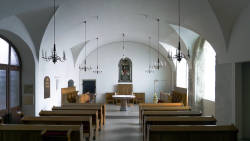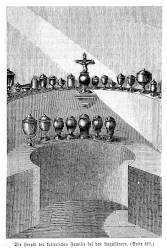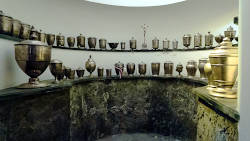Herzgruft
Useful Information

| Location: |
Augustinerstraße 3, 1010 Wien.
(48.205817, 16.367789) |
| Open: |
All year Mon, Wed, Fri 7:30-17:30, Tue, Thu 7:30-19:15, Sat, Sun 9-19:30. [2023] |
| Fee: |
free. [2023] |
| Classification: |
 Crypt Crypt
|
| Light: |
 Incandescent Incandescent
|
| Dimension: | |
| Guided tours: | self guided |
| Photography: | not allowed |
| Accessibility: | no, five steps |
| Bibliography: | |
| Address: |
Augustinerkirche Wien, Augustinerstraße 3, 1010 Wien, Tel: +43-1-533-70-99.
E-mail: |
| As far as we know this information was accurate when it was published (see years in brackets), but may have changed since then. Please check rates and details directly with the companies in question if you need more recent info. |
|
History
| 1327 | Duke Friedrich der Schöne (Frederick the Handsome) founds cloister with church for the Augustinian friars. |
| 12-SEP-1627 | Loretokapelle consecrated by Cardinal Franz von Dietrichstein in the presence of the imperial court. |
| 1634 | Augustinerkirche becomes the imperial church. |
Description


The Herzgruft (Heart Crypt) is located at the Augustinerkirche (Augustinian Church), a parish church located on Josefsplatz, next to the Hofburg. The Hofburg is the winter palace of the Habsburg dynasty in Vienna and the Augustinian Church was the parish church of the imperial court of the Habsburgs. The church was built in the 14th century and became Imperial church in the 17th century. Numerous Habsburg weddings took place here.
The Loretokapelle was created on the order of Eleonora of Mantua, wife of Emperor Ferdinand II. She wanted a Loreto Chapel in the Augustinian Church which would resemble the Casa Sancta in Loreto (Marche, Central Italy). She sent architects to the original in 1624 to have precise measurements taken. On 12-SEP-1627 the copy was consecrated by Cardinal Franz von Dietrichstein in the presence of the imperial court. The empress donated valuable jewellery, several crowns and a large eagle made of precious stones. Subsequently, the nobility also endeavoured to contribute to the embellishment of the chapel. The chapel got Silver doors, lamps and angels. It was even used for two wedding, but it was actually too small.
The Loreto Chapel became the most important pilgrimage centre for the citizens of Vienna. In the course of the regotisation of the church in 1784, the chapel was pulled down, but rebuilt at the insistence of the people. Emperor Joseph II designated the lower part of St. George’s Chapel for this purpose, a room that had served the monastery as a chapter house in the Middle Ages.
King Ferdinand IV decreed in his will that his heart should be laid at the feet of the Mother of God after his death. Ferdinand died in 1654, and in the same evening, the body was embalmed and the cup with the heart was displayed on the show bed. One day after his death, on 10 July at 9 p.m., the heart was transferred to the Loreto Chapel and buried at the feet of the Madonna. This gave rise to the custom of burying the hearts of the Habsburgs in the heart crypt, today a total of 54 hearts rest in the modest crypt.
Strictly speaking the crypt is not underground, which actually applies to many subterranea. Nevertheless, the crypt definitely gives the impression of being in an underground vault. And the ritual distribution of mortal remains in different places is a weird but actually quite common habit. The custom was motivated by hygienic reasons since earliest antiquity. In the case of the Habsburgs, the mortal remains are in the Capuchin crypt, the entrails in the entrails crypt under the choir of St Stephen’s Cathedral and the hearts in the heart crypt in the Augustinian Church.
 Search DuckDuckGo for "Herzgruft"
Search DuckDuckGo for "Herzgruft" Google Earth Placemark
Google Earth Placemark Herzgruft - Wikipedia (visited: 11-JAN-2023)
Herzgruft - Wikipedia (visited: 11-JAN-2023) Rundgang durch die Kirche
Rundgang durch die Kirche  (visited: 11-JAN-2023)
(visited: 11-JAN-2023) Index
Index Topics
Topics Hierarchical
Hierarchical Countries
Countries Maps
Maps